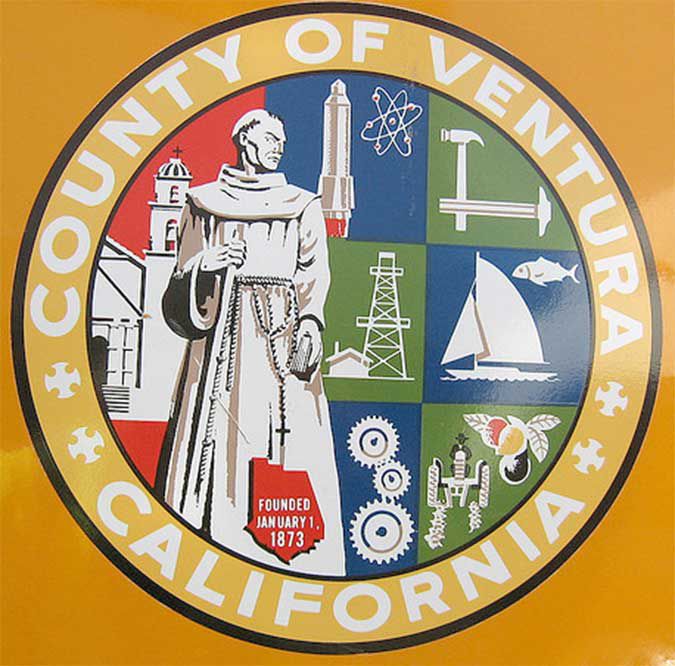The official seal of Los Angeles County has changed twice since its first inception in 1887, when the original 1887 county seal displayed grapes, surrounded by the words "Board of Supervisors — Los Angeles Co. Cal."
On March 1, 1957, the Board of Supervisors adopted a new seal, designed by Supervisor Kenneth Hahn and drawn by Millard Sheets. Its features included the cross which represented the influence of the church and missions of California. Additionally:
---An image of Pomona, the Roman goddess of fruit trees, holding in her arms a sheaf of grain, an orange, a lemon, an avocado and grapes, represented the county's agriculture. She stands on the shore of the Pacific Ocean with the San Gabriel Mountains in the background.
---Engineering instruments (the triangle and caliper) represented the county's industrial-construction complex; oil derricks represented oil fields discovered on Signal Hill.
---The Spanish galleon represented the San Salvador, the vessel commanded by Juan Cabrillo that sailed into San Pedro Harbor on Oct. 8, 1542.
---A tuna represented the county’s fishing industry; the championship cow, Pearlette, represented its dairy industry.
---The Hollywood Bowl represented county cultural activities; two stars represented the motion picture and television industries.
In 2004, the seal was altered. In place of Pomona, a Native American woman represents the early inhabitants of the Los Angeles Basin. She stands on the shore of the Pacific Ocean with the San Gabriel Mountains and the sun in the background, and is surrounded by six smaller images:
---On her right: the engineering instruments of a triangle and a caliper (representing the industrial construction complex of the county and its vital contribution to the exploration of space); a Spanish galleon (Juan Rodríguez Cabrillo's ship the San Salvador, which sailed into San Pedro Harbor on Oct. 8, 1542); and a tuna fish (representing the fishing industry).
---On her left: the Hollywood Bowl (representing the county's cultural activities, with two stars to represent the motion picture and television industries); Mission San Gabriel Arcangel (representing the historic role of the missions in the settlement of Los Angeles, but without a cross); and the championship cow Pearlette (representing the dairy industry).
This seal was adopted by a majority of the Board of Supervisors on Sept. 14, 2004, after the American Civil Liberties Union threatened a lawsuit over the presence of the cross in the previous seal.
In the Los Angeles Archdiocese’s other two counties:
---Ventura County’s seal (pictured) features a prominent image of Blessed Junípero Serra, founder of Mission San Buenaventura, and the mission itself, with cross, behind him. Also featured are images representing county industries (including agriculture, fishing, oil, building and tourism).
---Santa Barbara County, whose roots also can be traced to an historic Catholic mission, features on its seal an image of the historic courthouse.
And one final note: As mentioned in The Tidings last Sept.6, the official seal for the City of Los Angeles, authorized in 1905, includes the Stars and Stripes of the United States, the California Bear Flag, the eagle and serpent (from the arms of Mexico), and the castle of Castile and lion of Leon (from the arms of Spain). Sprays of olive, grape and orange suggest the location of Los Angeles as a “city set in a garden.”
Yet perhaps its most interesting feature is the depiction of the Rosary (the Franciscan Crown version), representing the Franciscan Fathers who civilized and settled much of California.
---Mike Nelson and Hermine Lees

